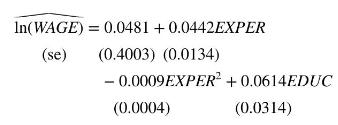Consider the data file (m r o z) on working wives. Use the 428 observations on married
Question:
Consider the data file \(m r o z\) on working wives. Use the 428 observations on married women who participate in the labor force. In this exercise, we examine the effectiveness of alternative constructed instrumental variables. Estimate the model in Example 10.5 using IV/2SLS using both MOTHEREDUC and FATHEREDUC as IV. These will serve as our baseline results.
a. Write down the first-stage equation using econometric notation, as in equation (10.26), with \(\gamma_{1}, \gamma_{2}, \gamma_{3}\) as the unknown coefficients of the intercept, EXPER and its square, and \(\theta_{1}, \theta_{2}\) as the coefficients of MOTHEREDUC and FATHEREDUC, respectively. Test the null hypothesis that \(\theta_{1}=\theta_{2}\) at the \(5 \%\) level. What do you conclude?
b. Assume that \(\theta_{1}=\theta_{2}=\theta\). Substitute into the first-stage equation to obtain a "restricted" model. What variable involving MOTHEREDUC and FATHEREDUC now appears on the right-hand side?
c. Create a new variable PARENTSUM \(=\) MOTHEREDUC + FATHEREDUC. Obtain IV/2SLS estimates using this as the IV. How do the estimates compare to the baseline results? Is this IV strong?
d. Create two new variables \(M O M E D 2=\) MOTHEREDUC \({ }^{2}\) and \(D A D E D 2=F^{2} A T H E R E D U C^{2}\). Use these new variables and both MOTHEREDUC and FATHEREDUC as IV. Estimate the first-stage equation using these four IV. Test their joint significance using an \(F\)-test. Are these instruments adequately strong? Do any seem irrelevant based on \(t\)-tests of significance? Find the simple correlations among the four IV. Are any large?
e. Obtain IV/2SLS estimates of the model in Example 10.5 using the four IV in part (d). How do these estimates compare to the baseline results and to those in part (c)?
f. Based on the results in this question, which set of IV/2SLS estimates would you prefer to report? The baseline estimates, the results in part (c), or the results in part (e). Explain your choice.
Data From Equation 10.26:-

Data From Example 10.5:-
In addition to education a worker's experience is also important in determining their wage. Because additional years of experience have a declining marginal effect on wage use the quadratic model

where EXPER is years of experience. This is the same specification. We assume that EXPER is an exogenous variable that is uncorrelated with the worker's ability and therefore uncorrelated with the random error \(e\). Two instrumental variables for years of education, \(E D U C\), are mother's and father's years of education, MOTHEREDUC and FATHEREDUC, introduced in the previous examples. The first-stage equation is

Using the 428 observations in the data file mroz the estimated first-stage equation is reported in Table 10.1. The IV/2SLS estimates, with correctly computed standard errors, are

The estimated return to education is approximately \(6.1 \%\), and the estimated coefficient is statistically significant with a \(t=1.96\).

Step by Step Answer:

Principles Of Econometrics
ISBN: 9781118452271
5th Edition
Authors: R Carter Hill, William E Griffiths, Guay C Lim





